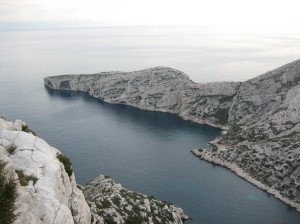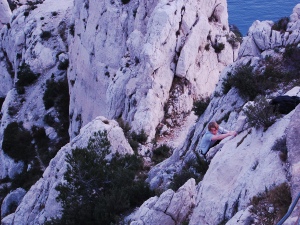Climbing
Ahh, summer in Boston. These are some photos of what I’ve been doing when the weather is nice (unfortunately right now is drizzling and miserable).
More landlord drama
For those of you that don’t know, our landlord is a complete douchebag, and he has managed to demonstrate that more fully this month. Just for a quick backstory, my roommates and I had to hire a lawyer within the first week of moving in because he was trying to claim that our lease was invalid and wanted to make us pay more for rent etc etc.
Last month we were informed that he would be selling this property, so we wouldn’t be able to renew our lease. Despite the problems we had with him, we like the house and the location (and moving in general is a hassle). But whatever, if he’s selling there’s not really much we can do about it. Then 3 things happened all at once: we noticed that our house was posted for rent on craigslist, we got a letter in the mail that said we were delinquent on rent and that if we didn’t pay soon, they would start eviction proceedings and screw up our credit, and a Realtor came by to show our place to a bunch of college kids (clearly not interested in buying a multi-million dollar home).
First of all, we double checked our bank accounts and all of our rent checks had been cashed 2 weeks prior, and added up to the right amount. Second, we’re pretty sure that this guy just has a racket to re-rent the house every year to get someone a realtor fee and to stiff kids out of their security deposit (we’re fairly certain that we’ll have to go to our lawyer to get that back). So in the mean-time, we’re looking for new appartments and chances are I won’t be living with the same people again (finding a house this large is terribly difficult in Cambridge).
Lame.
Short update
I’m terrible at keeping this thing updated, I’m aware, but to be honest, not that much has happened recently.
I finally finished up my 1st rotation on micro-RNA’s. It went pretty well in terms of getting to know the lab and the environment, but my experiments weren’t particularly successful. Then again, the point of lab rotations really doesn’t seem to be getting stuff accomplished. I was supposed to start my next rotation today, but space isn’t going to open up until next week, so instead I’ll just give a brief explanation of what I’ll be studying: Toll-like receptors (TLR’s).
TLR’s are proteins on the surface of the cell that detect bad-guys and tell the immune system to react. These are different than the receptors on B-cells and T-cells, which can be randomly generated to recognize almost any molecular pattern (so when the flu and cold viruses mutate ever year, you can make a new response to them). Instead, TLR’s are hard-wired by evolution to detect things that the pathogens have a hard time changing, and are present on almost every cell type. That way, if you get infected by a bug that you’re B- and T-cells have never seen before, the TLR’s can still tell the rest of the boddy, “Hey, something’s not right here,” and mount up a preliminary response to give the B- and T-cells time to get in the act.
My project will be to work on the evolution of these receptors. The first one was discovered in fruit flies (and is simply called “Toll”), where it is important in the response to fungal infections. The immune system of insects is dramatically different from that of vertebrates, but nevertheless, the original Toll gene was clearly duplicated and mutated to recognize a variety of different signals (humans have at least 10, mice have 13). I don’t have details yet about what exactly I’ll be studying about the evolution of these TLR’s, but I’ll let you know when I do.
Beyond that, not much to report. Classes are going fine but there’s a lot of reading to get done. I’ve also been climbing a bunch (I knocked out my first 5.10b today). Hopefully when the weather gets warmer I’ll be up for some out-door stuff. Keep checking back, I’m really going to try to keep this current.
Fun with accronyms and other oddities
The new semester has started, and I’m already neck-deep in scientific literature. Before classes even started I had 8 papers to read (it takes me between 30min and 2 hours to get through one), and now that I’ve had 2 classes I have several more. I’m also sick (for like the 4th time this winter), and in my fever-induced delerium I found myself fixating on a few oddities in biological writing. One is an incredibly high reliance on compund accronyms. Here’s an example from the paper I’m currently reading:
IL-1 = Interleukin 1.TIR = Toll/IL-1 Receptor.TIRAP = TIR-domain-containing Adaptor Protein. TRIF = TIRAP inducing Interferon-beta. TRAM = TRIF Related Adaptor Molecule
So in other words, “TRIF” stands for “Toll/Interleukin-1 receptor domain containing adaptor protein inducing interferon-beta related adaptor molecule.” Impressive eh?
Another strange bit of biological-science related language (BSRL) is the use of impressive-sounding words that have rather simple synonyms. The 2 examples that come readily to mind are “Stochastic” (random), which as a euphimism for “something we have absolutely no explanation for,” and “abrogate” (stop).
Edit: I thought of a couple others: Paucity (lack of) and Ellucidate (figure out). As in, “it is impossible to ellucidate the reasons behind the seemingly stochastic use of vocabulary among biologists and there seems to be a paucity of methods to abrogate this behavior.”
Herpes Cure?
Well, not exactly. But this is a great example of new approaches to preventing disease using the tools of modern biology. It’s even cooler because it comes out of the lab that I’m working in.
Judy Lieberman, professor of pediatrics and a senior investigator at the Immune Disease Institute, has overseen the development of the treatment that uses RNA interference, or RNAi, to disable key genes necessary for herpes virus transmission. That cripples the virus in a molecular two-punch knockout, simultaneously disabling its ability to replicate, as well as the host cell’s ability to take up the virus.
This isn’t my project, but RNAi is closely related to microRNAs (which is what my project is). Both involve double-stranded RNA in the cell that interferes with the expression of particular proteins in a specific way. The only difference is that microRNAs are endogenously encoded (the code for them exists on a cell’s own DNA) and RNAi uses RNA introduced from an outside source. Once the RNA is out in the cell though, they both use the same molecular mechanisms to block translation of their targets. Since it’s discovery, RNAi has been extremely useful in studying what particular genes do (the best way to learn about something is to break it and see what else goes wrong), but it’s potential for theraputic use has been elusive.
Many in the field think RNAi-based drugs may be the next important new class of drugs. By introducing tiny RNA molecules into cells, researchers can target a gene of interest and, in effect, throw a wrench into that gene’s ability to build protein molecules. For all intents and purposes, that gene is now disabled.
While RNAi has profoundly accelerated the ability of scientists to probe and interrogate cells in the petri dish, therapeutic breakthroughs have proved far more problematic. Researchers have had a difficult time delivering these tiny RNA molecules and ensuring that they actually penetrate the desired cells and tissues in a living organism.
Modifying a delivery technique that Lieberman developed in 2005, she and postdoctoral fellow Yichao Wu and junior researcher Deborah Palliser (who now heads her own laboratory at Albert Einstein College of Medicine) treated mice with strands of RNA that were fused to cholesterol molecules, which made it possible for the molecules to pass through the cell membranes.
This approach works well in mice, but now needs to be developed for humans. The other problem is that it’s prophylactic, meaning it’s just a preventative measure and would not be able to treat people that are already infected, but it could be the first step in generating preventative tools for any number of STDs.
Last 2 weeks
Last week, I went to Marseilles for a conference on visualizing the immune system at le Centre d’Immunologie Marseilles-Luminy. It was more or less entirely paid for by my program, which was cool, but we basically spent the entire week sitting in a lecture hall, which was not. We did get to spend a little time in the city center and were able to walk out to the coast where I did a little bouldering.




On the way back, we had a 7 hour layover in Amsterdam, so we caught a train into the city and wandered around. It’s a beautiful city, but in order to experience it fully, I think I have to go back when it’s not Sunday morning. When we got back, I was picked up from the airport by my roommate and we drove directly to Washington D.C. for Obama’s inauguration: a grand total of 28 hours of straight traveling (with 2 hours sleep in that time). We woke up Tuesday morning around 6am and walked into the city from Virginia to get a spot near the Washington monument. We could see the capitol building from where we were, but had to watch the actual events on the jumbotrons.



Now it’s back to work. Classes start on Wednesday, but I already have like 8 papers assigned. This semester is gonna be rough…
How Science Works
I really couldn’t put it any better than this.
Science is so much more than the simplified “observation ->hypothesis ->data ->conclusion” that we learn in highschool, yet most science classes focus merely on the details of past scientific discoveries, and spend almost no time on the actual process. Carl Zimmer says it better than me:
These questions may seem too abstract to bother with. We all know what science is, right? So why don’t we just cut to the chase, and learn about black holes and viruses and everything in between? Pondering the nature of science is important, though, because understanding how science works lets us get much richer, deeper feel for what we do–and don’t–know about the natural world.
It also might get the masses that buy into anti-science bullshit to appreciate that scientists are not out there trying to corrupt their poor Christian children with godless ideas, but are in fact searching for an understanding of the natural world.
Well, probably not, but it’s worth a try.
Happy New Year!
Hope everyone had a great time last night, and no one is too hung over.
Here’s hoping 2009 brings all the wonderful things we’ve been waiting for (not likely, but it’s nice to dream).
New site
I just moved over here from kescobo.blogspot.com.
I intend for this blog to keep family and friends posted on developments in my life and to talk about things I find interesting (which will include mostly biology, religion, and politics, not necessarily in that order). If you are reading, please comment!
-Kevin
-
Archives
- May 2009 (1)
- March 2009 (3)
- January 2009 (5)
- December 2008 (1)
-
Categories
-
RSS
Entries RSS
Comments RSS


